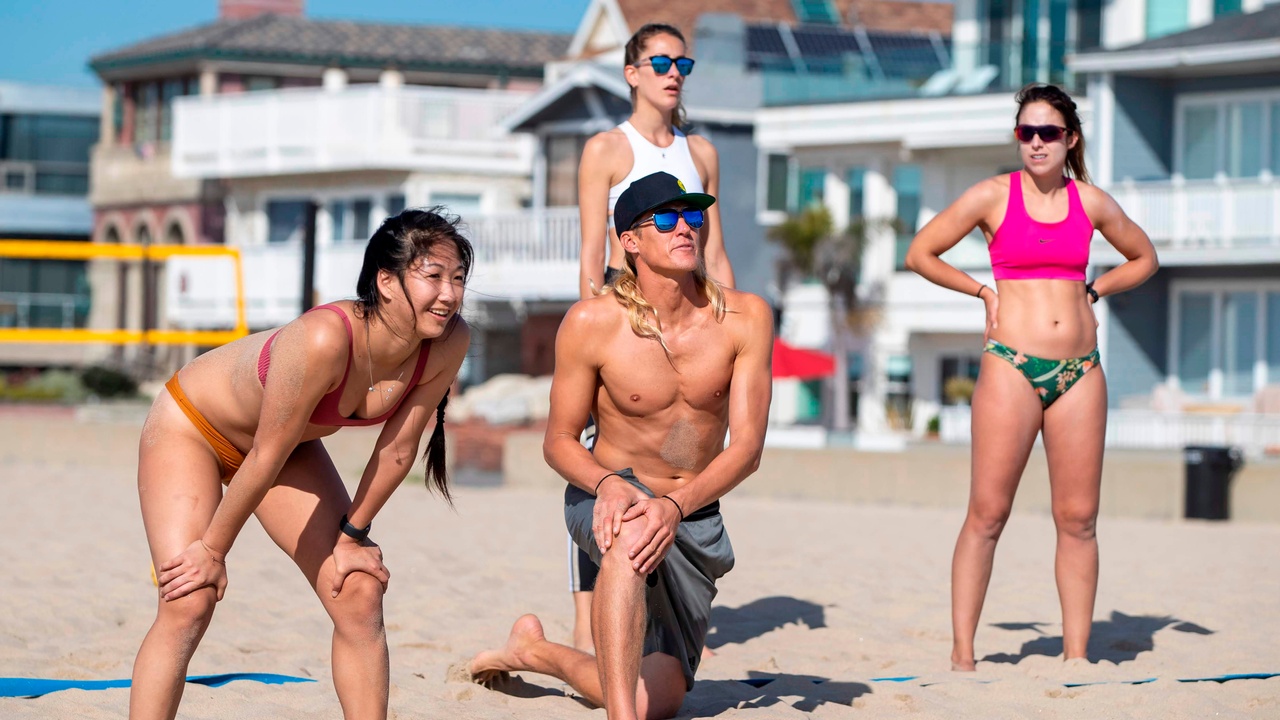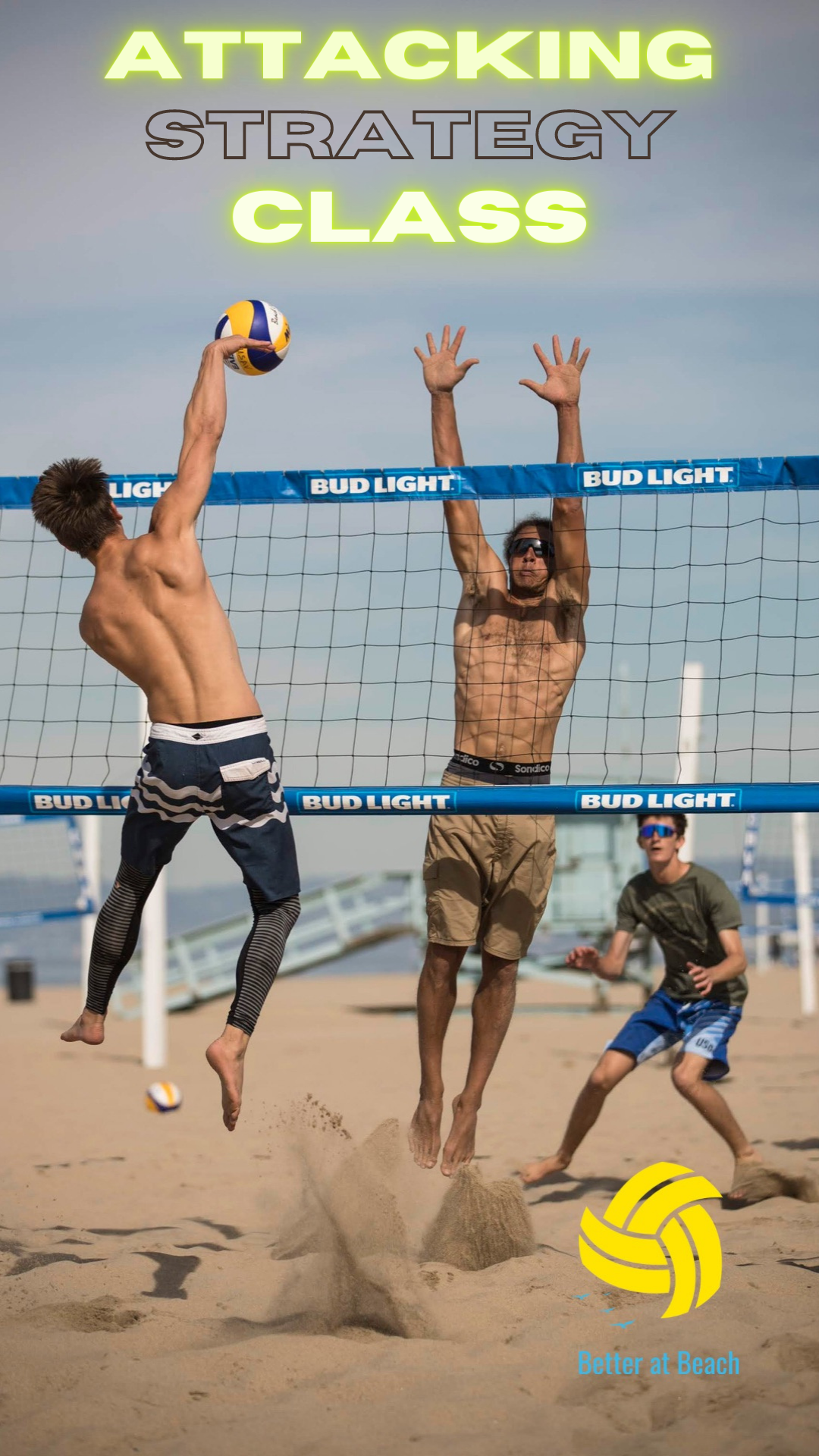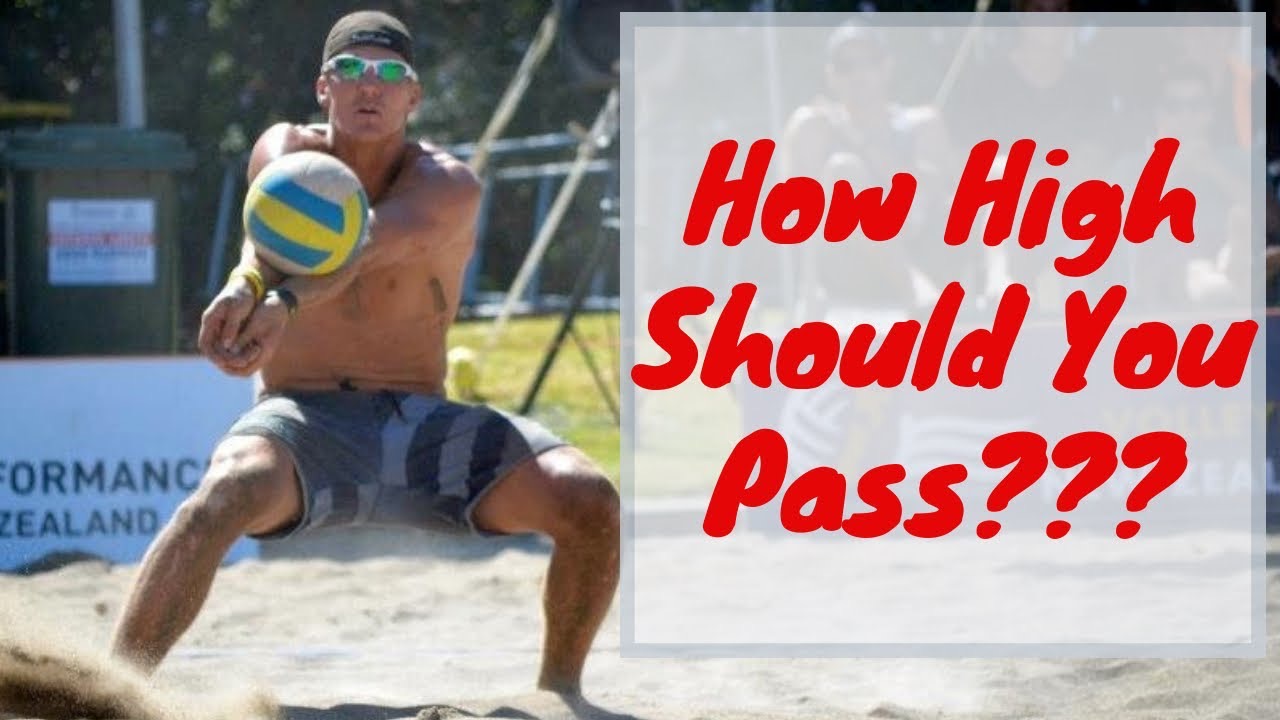
How to Pass A Volleyball - Special Situations
Special Situations for Passing a Volleyball
Did you finish reading "How to Pass a Volleyball - Advanced Footwork and Drills" and crave more information?
We covered positioning on the court, passing, and footwork in the last few blogs on How to Pass a Volleyball. Here, we'll go over some special situations to help develop a deeper understanding of the game.
Passing height is a controversial topic in the beach volleyball world. Should I pass low? Should I pass high? How high is high? How low is low? What if I have a bad setter?
These are all important questions that will be answered right here.
What's we will cover:
- How High Should You Pass in Volleyball
- How Far Off The Net Should You Pass in Volleyball
- Where Should You Pass in Volleyball
- How to Change Your Pass in Volleyball When It's Windy
HOW HIGH SHOULD YOU PASS IN VOLLEYBALL
First, it’s important for the pass to have an apex or a top. When the ball has a downward flight that allows your setter to get under the ball and establish a balanced footing, they will have the opportunity to be more stable and therefore more accurate.
There is no hard and fast rule when it comes to height that is perfect for everybody, but 15 feet in the air is a great starting point. This equates to six balls above the top of the antenna on a men’s beach volleyball net, or seven balls above the top of the antenna on a women’s beach volleyball net.
This might sound high to some people, but I assure you that in the natural rhythm of play, this is a very comfortable height.
When the trajectory of a pass is more sideways than up and down, it will still be approaching the net as the setter is trying to make their play. This causes the setter to catch up to the ball instead of allowing them to calmly get under it and choose how to direct their own momentum.
In a perfect beach volleyball world, the setter should have their final momentum headed toward their target.
If we parallel AVP setters in volleyball to shooters in the NBA, basketball players will be more accurate with jump shots when they aren’t floating sideways as they shoot. The same is true for setters. If a player's momentum is still carrying him or her towards the net because of a flat, fast pass, it will be harder for them to deliver the perfect set.
It is true that, thanks to the laws of gravity, that a lower pass will be moving slower by the time a setter touches it. Compared to a high pass, this makes it easier to handle, but this advantage is often negated when a setter has to rush because the pass is too low.
One of the advantages to passing a little bit higher is that it allows time for our setter to adjust if we make an errant first touch. If we only get the ball to the top of the antenna but we miss right or left, we can be certain that our setter will be very low on time and probably end up diving, or at least lunging, to make the next play.
Further, getting the ball to at least 15 feet allows the hitter a short but crucial moment to get into their attack position. We are going to talk about Point of Hesitation later, but keep in mind that it is more difficult to get to our offensive starting position and deliver a hard, accurate spike if we don’t put a little air underneath the first touch.
HOW FAR OFF THE NET SHOULD YOU PASS IN VOLLEYBALL
We should be trying to land every pass and first touch about six feet from the net. It is ok if the setter ends up a little bit closer, but since we are not perfect, some of our passes will naturally travel beyond our aiming point and some will fall short.
Knowing the statistics of the bell curve, we need to pick a passing location that allows for some wiggle room. If you aim your passes three feet from the net and miss by just one step, your setter will have to contort their body in strange ways just to prevent themselves from touching the net while they set.
If you aim at six feet, you allow a little leeway to miss, which is always excellent to have. If we fall short of six feet and we end up passing to nine feet, we are still in a very comfortable sideout position. The ball and the setter should always be between us and the defense before we take a spike approach.
If you were to take a picture just before starting your spike approach, the ball and the setter should be in the foreground and the other team should be in the background. This is imperative for offensive vision, especially if you are learning how to spike better in beach volleyball. We dive into attacking in beach volleyball more in depth in our Complete Player Program.
The last thing we want to do is pass too tight, or worse, give the ball to the other team with an overpass.
Oftentimes, players will receive a serve or a dig close to the back line and they cut the distance in half. Setters will expect the ball to be passed to half court because they believe it will be easier to set if the ball isn’t traveling so far and so high as to cover the length of the court.
This is shortsighted and will lead to an ineffective offense. In all situations, except for easy options, we should be trying to land our passes and digs six feet from the net.
The video below is lengthy, but it's from one of the live webinars where we talk about how to design a beach volleyball offense. It should start at 15:41. Take special note of where all of the passes are landing.
WHERE SHOULD YOU PASS IN VOLLEYBALL
Years ago, beach volleyball players everywhere were taught to pass directly in front of them.
This was an unfortunate over-simplification of the best pass location. We do want to make sure (for the basic offensive design) that the pass lands in front of us so that the setter and the ball are between our attacker and the net. We have to be able to see our setter and the other team at the same time. If you have to look sideways or backwards to see the ball and the setter, you are in a bad spot.
This allows a “one picture” view of the setter, the ball and the defense. Servers are always trying to put pressure on their opponents, so fast serves lock both players until the last second. This means setters don’t have much of a chance to leave their starting position prior to the serve receive, so it’s best practice to leave the ball closer to them towards the middle of the court.
It’s best to aim the pass so that it travels at a 30 degree angle off of our inside foot. This gives the setter time to easily get under the ball and sets up a good angle for our option hitters. If they want to set instead of spike, they won’t have to chase the ball. The ball approaches the setter.
The 30 degree pass angle also ensures we won’t get trapped against the antenna and be forced to take our approach directly at a scary 7-foot blocker, like Logan Webber. When we open the court a little bit, we at least force big blockers to move and make angle calculations to set up their block. When blockers can use the antenna as a boundary, it’s easier for them to know where they should stand and what their hands have to cover.
The game has evolved and is continuing to do so every day.
The On-2 and the Spread Offense are here to stay. Leaving a pass directly in front of the receiver creates a chase situation for the setter/On-2 hitter and it eliminates your offensive options. Leave your passes 30 degrees off of your inside leg and 6 feet off the net. You will start to see more accurate setting and more opportunities for easy on two swings.
Like I mentioned before, the On-2 attack can be very effective when used in the right moment. If the setter’s only reason for attacking the ball was because it was high enough and close enough to the net, we need to re-evaluate that decision-making process. There needs to be more thought and strategy when spiking the second ball.
In most instances, the On-2 attack is supposed to be an offensive attack that takes advantage of our speed and the defense’s lack of time to prepare.
This is very different from a power swing, where we have to overcome a defender’s stable base of reactions. The On-2 attack should occur when the setter or 2nd person to contact the ball sees or feels an opening on the court. It should be more of a quick slap than a fully loaded swing. Jumping as high as you can and swinging as hard as you can takes valuable extra milli-seconds that shouldn’t be wasted for a swing meant to catch the other team before they set up. Learn more about how to master your arm swing mechanics and approach in our Attack Strategy Class.

If the On-2 hitter takes a full approach, he or she might give away the element of surprise too early and lose the chance to catch the defense off balance. An ill-formed defense can be in the form of a block that won’t get built-in time, a defender not covering the whole court, or both.
This path is often left open by blockers who only pay attention to the person who passed the ball. The world’s best blockers defend the setter first and then the person who received the ball.
There are lots of opportunities to accelerate balls into broken blocks or open areas without necessarily powering them there. The load and double arm lift required to jump with max height and power might give away our intention too early and cost us those precious milliseconds we could use to beat the unbuilt defense.
Again, it’s important for every player to learn how to beat teams in a way that takes advantage of our quickness and their imbalance. It’s another offensive weapon when most of us only think of either power or soft shots.
Going back to the beginning, we need to understand when and if we can see the defense so we can take advantage of a good decision-making process. This might change the location of the first touch.
When we receive the ball in the front half of the court, we're passing a short serve, short free ball, or digging a cut shot. This is a great opportunity for us to attack On-2. The setter should be waiting around half court to set (or hit) so when the first touch gets laid up along the net, the setter has an easy view of the other team.
Want to show your support and help us make more content?
This is some of the cool beach volleyball gear we recommend.
 |
|
|---|---|
|
Murray Sporting Goods Dry Erase Double-Sided
|
Mistakes in the decision process come when a setter wants to attack a ball that is coming from behind them. When you have to look backwards for a ball, you cannot see the defense in front of you, so you are swinging blind, which is never a good idea.
As a great rule of thumb when developing a beach volleyball offense, do not try to attack a ball On-2 that is coming from the back half of the court. Set the ball so your partner can use their vision to make an informed swing. If the receiver/passer is under control when going for the short ball, teams can cue each other to run an On-2 or Spread Offense.
If the receiver is balanced and has great ball control, this might be an opportunity to pass tighter than usual, and force the setter to swing on an open net. If you know the other team is out of position and your partner is ready to attack, dig or pass it a little tighter than you might otherwise do. If the other team has a change of putting a blocker in front of the attack, pass a tiny bit farther from the net so you can run the On-2 Offense or the Spread Offense.
This is mainly useful if you play against blockers who have a significant net presence. It is very difficult for a blocker to get stable and make strong, structured moves when they are trying to cover two attackers spreading the ball across the court.
The threat of the On-2 combined with a spread hitter can destroy a defense's ability to set their feet and make clean moves. The short serve or short free ball would be a time when it might be ok to pass the ball tighter to the net. We just need to make sure we are balanced and confident in our ball control before forcing a tight pass.
HOW TO CHANGE YOUR PASS IN VOLLEYBALL WHEN IT'S WINDY
When playing in side wind, it’s important to really press the ball into the wind. This allows us to take advantage of the conditions Mother Nature has created.
Going back to our first lesson, it is easier for an attacker to hit a set that traveling with the wind, back into that same wind. Also, remember that the wind accelerates an object already traveling in the same direction, so the wind can take a ball far off course very quickly if we pass with an angle that directs the ball with the wind instead of into it.
This is when we can break the 30-degree rule from previous paragraphs. If I am playing the right side and the wind is coming from my right, I want to take advantage of that wind. To take advantage, I’ll need to pass directly in front of myself. This prevents the ball from spraying quickly with the wind and the setter can approach the ball while moving forward.
In extreme conditions, this means creating an angle that blocks the ball to the right side of my body and into the wind. My setter will have to cross my body line in front of me in order to make his/her play but that’s exactly what I want.
I want to go behind my setter and make him or her back set so that I can spike a set that is traveling with the wind. I can orient my body to take some big swings and hit some sharp angles back into the wind.
Running back sets in side wind can be the difference maker that gives you more opportunities for better swings and can lead to some tournament victories on windy evenings.
In summary, pass the ball 6 feet from the net at a 30-degree angle off of your inside foot. If the other team serves short, and the receiver is under control, consider passing a bit tighter to allow for the On-2 attack. Consider passing towards your partner's half of the court if you are trying to develop a Spread Offense.
When playing in side wind, pass the ball on the half of the court where the wind is coming from, and design your offense so that you can set with the wind and hit into it.
Watch my match below where I played with Logan Webber against Chase Frishman and Piotr Marciniak. It was a really windy day and you can see how often we scramble to try and hit from the good side.
If you need help getting better at passing, enroll in our course which has 19 lessons with video demonstrations. We take you step by step through the ins and outs of how to pass in beach volleyball. You'll also get access to all of our serve receive and passing drills. Better yet, sign up for the Complete Player Program and get access to the other skills courses at a huge discount.
Once you sign up, you'll be able to watch the in-depth tutorials, film your “before” videos, film your at-home drills and begin posting to our Private Facebook Group. Then, our coaches will break down your mechanics, footwork and touch on it at our weekly online meetings.
Yes, that means we look at YOUR videos and we coach YOU!***
SIGN UP NOW AND LEARN HOW TO WIN FROM THE PROS.
🔥 💪 🏐 JOIN OUR EMAIL LIST + FREE BEACH VOLLEYBALL DRILL BOOK 🔥 💪 🏐
GET YOUR FREE BETTER AT BEACH DRILL BOOK
🔥 💪 🏐 DOWNLOAD 3 COMPLETE BEACH VOLLEYBALL WORKOUTS 🔥 💪 🏐
3 FREE WORKOUTS FROM BETTER AT BEACH
🔥 💪 🏐 SUBSCRIBE TO THIS CHANNEL 🔥 💪 🏐
BETTER AT BEACH YOU TUBE CHANNEL
🔥 💪 🏐 GET SOME VOLLEYBALL SWAG & SUPPORT OUR CHANNEL 🔥 💪 🏐
BETTER AT BEACH VOLLEYBALL SWAG
🔥 💪 🏐 BEACH VOLLEYBALL VACATIONS AND TRAINING CAMPS 🔥 💪 🏐
JOIN US FOR BETTER AT BEACH VACATIONS AND CAMPS
🔥 💪 🏐 WANT TO ORGANIZE A CLINIC IN YOUR HOMETOWN?!?! 🔥 💪 🏐
Email: [email protected]
🔥 💪 🏐 VOLLEYBALL EQUIPMENT 🔥 💪 🏐
🔥 💪 🏐 FOLLOW 🔥 💪 🏐
VolleyChat! Facebook’s #1 Beach Volleyball Group
https://www.facebook.com/groups/579978042710748
https://www.facebook.com/betteratbeac...
https://www.instagram.com/betteratbeach
TikTok
https://www.tiktok.com/@betteratbeach...
https://www.linkedin.com/company/bett...
https://www.pinterest.com/Betteratbea...
🔥 💪 🏐 MORE VIDEOS ON... 🔥 💪 🏐
Passing
https://www.betteratbeach.com/blog?ta...
Setting
https://www.betteratbeach.com/blog?ta...
Attacking
https://www.betteratbeach.com/blog?ta...
Serving
https://www.betteratbeach.com/blog?ta...
Defending
https://www.betteratbeach.com/blog?ta...
Blocking and Peeling
https://www.betteratbeach.com/blog?ta...
Strength and Conditioning for Volleyball
https://www.betteratbeach.com/blog?ta...
Practice Planning and Coaching Advice
https://www.betteratbeach.com/blog?ta...
Match & Video Analysis
https://www.betteratbeach.com/blog?ta...
***
Once you sign up for our Complete Player Program, you'll be able to watch the in-depth tutorials, film your “before” videos, start and film your at-home drills and begin posting to our Private Facebook Group. Then, our coaches will break down your mechanics and spacing and timing at our weekly online meetings. Yes, that means we look at YOUR videos and we coach YOU!
SIGN UP NOW AND LEARN HOW TO WIN FROM THE PROS.






